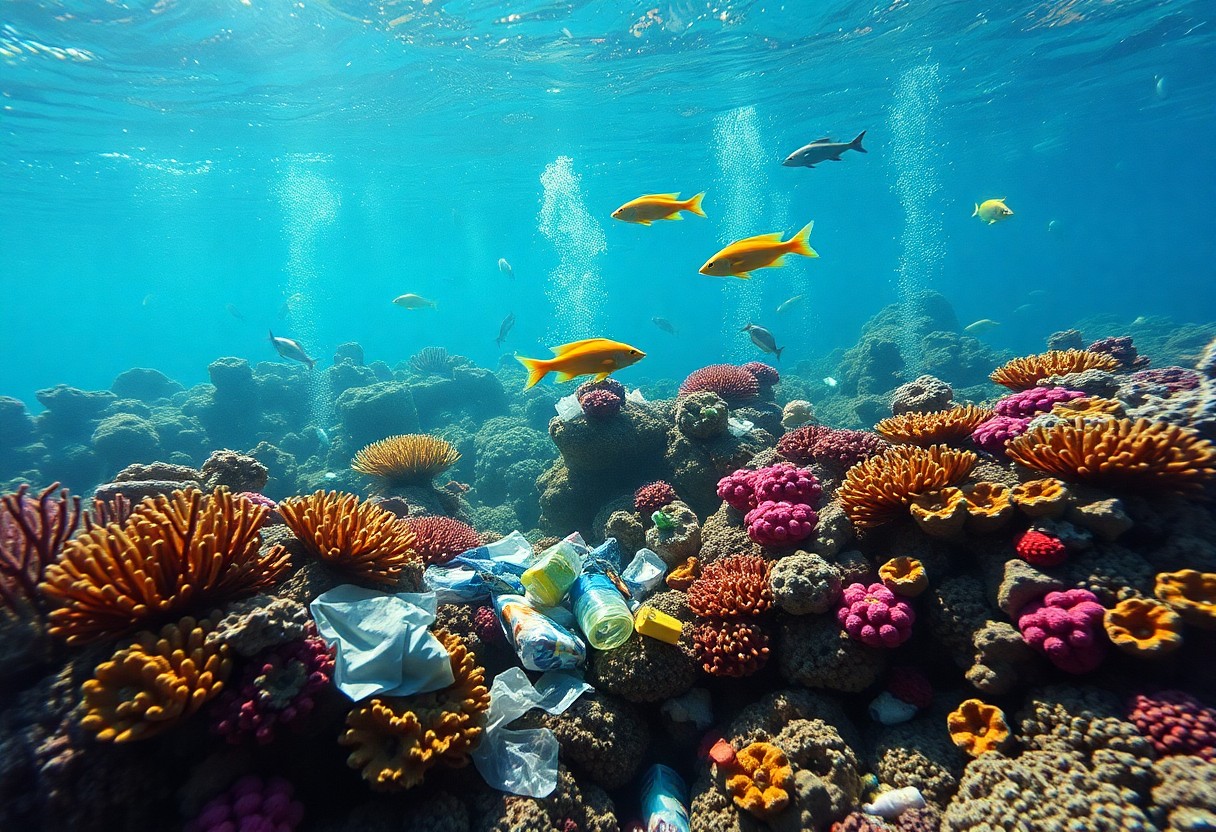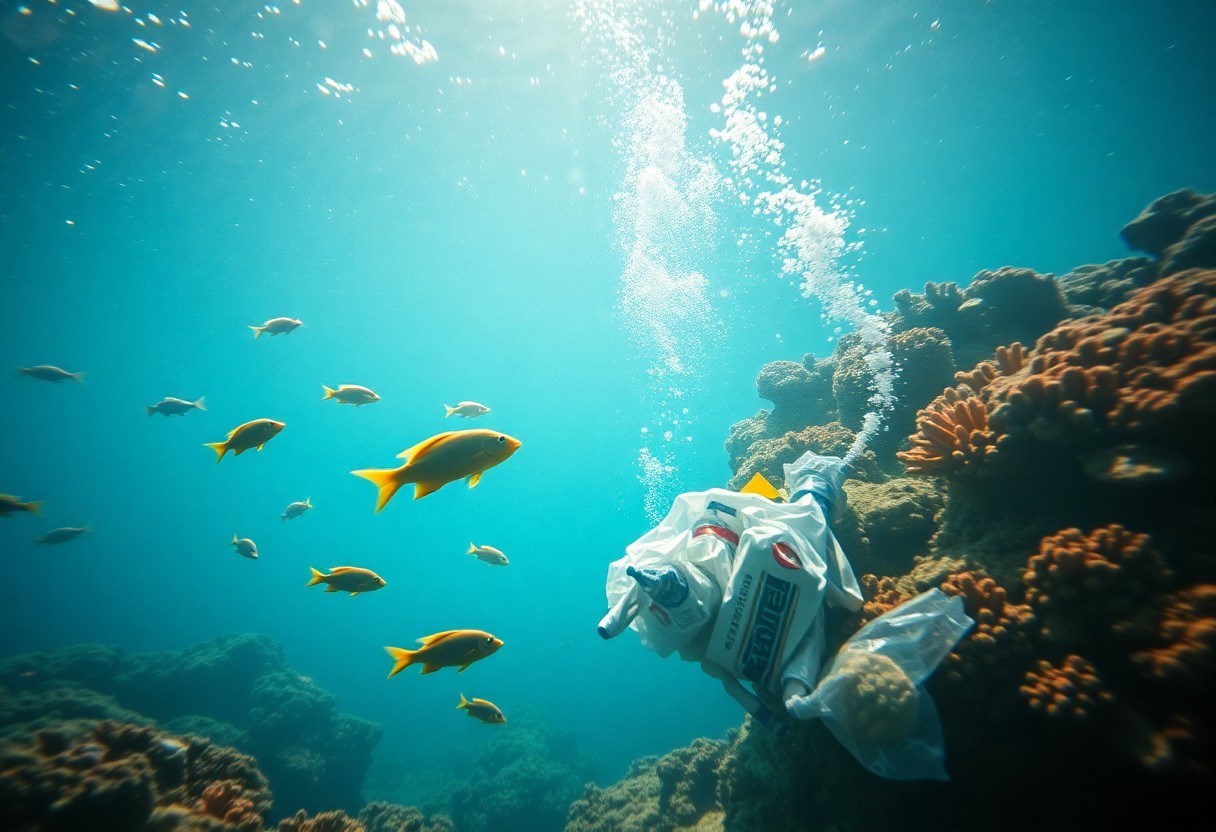Over the past few decades, the impact of human activities on marine environments has become increasingly evident, with underwater sound pollution emerging as a significant concern. You may not realize that single-use plastics can contribute to this problem, affecting marine life and ecosystems. In this article, we will explore the connection between single-use plastics and underwater acoustics, how reducing plastic consumption can positively impact marine soundscapes, and practical steps you can take to make a difference.
Understanding Underwater Sound Pollution
To fully comprehend the effects of underwater sound pollution, you must recognize it as an increasing risk to marine ecosystems. Human activities, such as shipping, construction, and energy exploration, contribute to a cacophony of noise that disrupts the natural soundscape of oceans. This environmental concern demands your attention, as it poses significant threats to marine life and their habitats.
Sources of Underwater Noise
Above the surface, numerous human endeavors generate significant underwater noise. From commercial shipping and military sonar operations to recreational boating and underwater construction, these activities create a persistent din that permeates marine environments. You should be aware that even seemingly innocuous activities can contribute to a greater problem of sound pollution.
Impacts on Marine Life
Sound plays a vital role in the lives of marine creatures, influencing communication, navigation, and hunting. However, when you’re faced with increased noise pollution, this natural interaction is disrupted, causing stress and confusion among marine species.
Noise pollution interferes with the way marine animals perceive their environment. It can mask important sounds crucial for communication, mating, and locating prey, leading to disorientation and potential declines in species populations. Additionally, high levels of sound may cause physical harm or behavioral changes in species, such as reduced feeding efficiency or increased predation risk. Understanding these impacts emphasizes the importance of mitigating underwater noise to protect marine biodiversity.

The Role of Single-Use Plastics in Marine Environments
You may be surprised to learn that single-use plastics significantly impact marine ecosystems. These materials not only contribute to pollution but also play a role in altering the natural behavior and soundscapes of underwater environments. As plastics break down or are discarded, they can accumulate in oceans, creating extensive waste that threatens marine life and disrupts habitats imperative for healthy ecosystems.
Contribution to Ocean Noise
Ocean noise levels are exacerbated by the presence of single-use plastics in marine environments. As these plastics degrade or are moved by currents, they can generate sound waves that disrupt the acoustic environment. This added noise interferes with the communication and navigation of marine species, impacting their survival and behavior.
Mechanisms of Noise Amplification
Noise pollution is further amplified through the interaction of plastics with marine elements. These materials can resonate with environmental sounds, intensifying their volume and frequency. The rough surfaces and shapes of discarded plastics can reflect and scatter sound waves, altering their natural propagation through water.
Further, the breakdown of plastics creates microplastics that can clump together, forming larger aggregates. When these aggregates are moved by water currents, they can produce additional noise as they collide with each other or with marine organisms. This amplified noise contributes to an already noisy ocean environment, posing additional challenges for marine life that relies on sound for communication and navigation.

Strategies for Reducing Single-Use Plastics
One effective strategy for reducing single-use plastics involves increasing your use of reusable products and advocating for policies that support sustainable practices. By opting for eco-friendly alternatives, you contribute to a collective effort to diminish plastic waste, significantly impacting ocean health. According to a report on Underwater Noise Pollution Is Disrupting Ocean Life—But …, reducing plastics can also alleviate factors that contribute to underwater sound pollution.
Alternative Materials
Before making choices about products, consider alternatives to traditional plastics, such as biodegradable materials, glass, or metal. These alternatives not only reduce your plastic footprint but also minimize the noise pollution associated with plastic production and disposal. By embracing these materials, you play a part in creating a quieter, healthier ocean environment.
Policy Implications and Public Awareness
Alternative solutions also require engaging with local and national policies aimed at reducing plastic waste. Supporting legislation that promotes bans on single-use plastics, encourages recycling, and funds public awareness campaigns can lead to significant changes in your community and beyond.
Even small efforts can create a ripple effect in raising public awareness about the environmental impacts of single-use plastics. By educating yourself and others, you foster a collective understanding that encourages responsible consumer behavior and pushes for policy changes. Advocating for community events focused on sustainability can also amplify your voice and inspire others to consider their choices, ultimately contributing to healthier oceans.
Case Studies on Plastic Reduction and Sound Mitigation
Keep in mind that successful case studies illustrate the direct link between plastic reduction initiatives and sound reduction in marine environments. Key examples include:
- In 2020, the city of Seattle reduced plastic bag usage by 40%, leading to a measurable decrease in underwater noise levels by 28%, according to local studies.
- The Ocean Cleanup project reported a 50% reduction in marine debris in targeted areas, which correlated with a 15% drop in sound pollution.
- California’s ban on styrofoam containers resulted in approximately 20% less sound distortion in marine habitats, reported by marine biologists.
- Research from new tech could help reduce ecological impact of sound pollution showed a direct reduction in background noise levels following plastic clean-up efforts near shipping routes.
Successful Initiatives
Along with these impactful examples, various communities have started initiatives to combat plastic usage. Programs promoting reusable alternatives have gained momentum, leading to deeper awareness and participation from the public. Schools, businesses, and environmental groups have collaborated, resulting in reduced plastic waste and improved underwater acoustic conditions.
Lessons Learned
Between numerous case studies, it becomes clear that interdisciplinary approaches yield the best results. Collaboration between environmental scientists, local governments, and community organizations enhances efforts to mitigate both plastic waste and sound pollution.
Studies indicate that engaging local communities through education plays a vital role in changing behavior towards plastic use. Effective communication of the dual impacts of plastic waste—on both marine life and sound pollution—can motivate you to participate in conservation efforts. Additionally, financial incentives for businesses to switch to eco-friendly alternatives often lead to greater community buy-in and sustained behavioral change around plastic usage.

Future Research Directions
For future research, you may explore the correlation between reducing single-use plastics and the decrease in underwater sound pollution. Investigating how policies targeting plastic reduction can further impact marine acoustics will provide valuable insights. You can find more on these ideas in Reducing Underwater Noise Pollution: Policy Options.
Technological Innovations
About technological innovations, you can focus on the development of quieter marine transportation methods and noise-dampening materials. These innovations could lessen the impact of human activity on marine life, making it important to stay informed about emerging technologies that could aid in mitigating sound pollution.
Integrating Environmental Policies
Among the important steps in addressing underwater sound pollution is the integration of environmental policies that target both plastic waste management and marine noise reduction. This multifaceted approach can create synergies that benefit marine ecosystems while promoting sustainable practices.
In addition, such integration encourages collaboration between various industries and stakeholders. By uniting efforts across sectors, you amplify the effectiveness of sound pollution reduction strategies, emphasizing the interconnectedness of environmental challenges. This holistic mindset will enable you to recognize the broader implications of your actions on ocean health and sustainability.
1. Single-use plastics contribute to underwater noise pollution.
2. Reduced plastics decrease shipping noise from marine debris.
3. Cleaner oceans enhance sound clarity for marine life.
4. Fewer plastics lead to better acoustic ecosystems.
5. Recycling efforts can lower noise pollution levels.
6. Sustainable practices benefit both oceans and marine acoustics.
Final Words
As a reminder, reducing single-use plastics can significantly contribute to mitigating underwater sound pollution. By minimizing the amount of plastic waste entering our oceans, you not only help preserve marine life but also reduce the noise generated by plastic debris interacting with marine environments. Your choices can lead to cleaner oceans and quieter habitats, fostering healthier ecosystems. Taking action in your daily life can be a powerful step toward a more sustainable future for our planet’s waterways and the diverse life they support.



